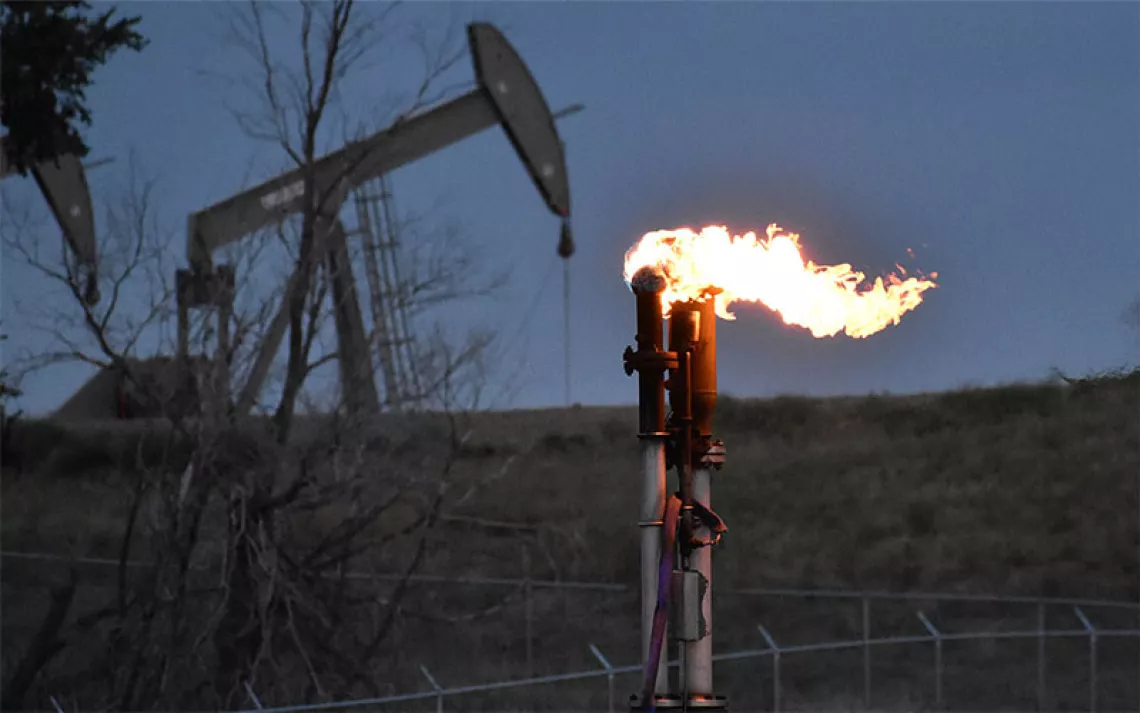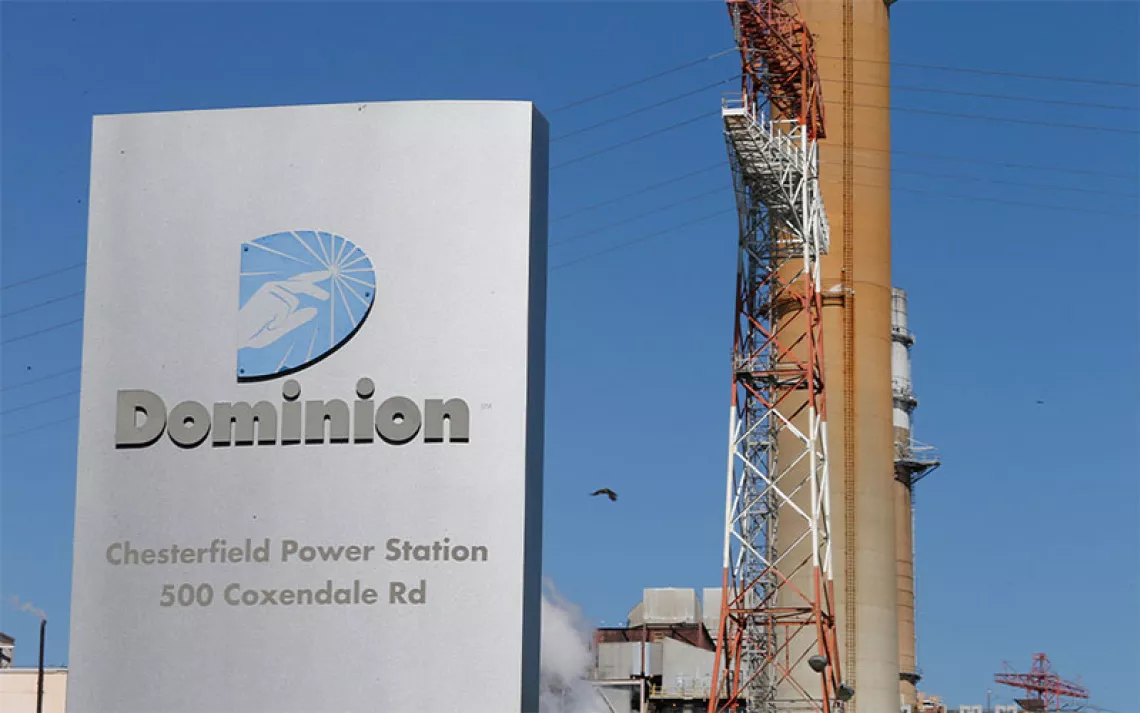LNG Exports: A Bridge Too Far
Booster of fracked gas touts questionable report pushing fossil fuels

Photo by Sky_Blue/iStock
On June 8, a group called the Western States and Tribal Nations (WSTN) Natural Gas Initiative released a report that claims natural gas sourced from the western Rockies and exported to certain Asian countries as liquefied natural gas (LNG) could reduce carbon emissions by 42 to 55 percent if it replaces coal-fired energy.
“WSTN is excited to announce that there is now definitive scientific evidence that exporting Rocky Mountain natural gas can significantly reduce global greenhouse emissions,” gushed Jason Sandel, chairman of the board for WSTN, in a press release. “To me, it is a no-brainer that LNG exports should be encouraged and fast-tracked with broad community and political support.”
WSTN bills itself as a consortium of state, county, and tribal interests “working to facilitate economic development and tribal sovereignty through the development of domestic and global markets for natural gas produced in the western United States.” The organization formed in 2019 with the express purpose of promoting LNG export terminals in Oregon and Baja California as the solution for moving stranded fracked gas from the western Rockies region. WSTN has strong ties to the Consumer Energy Alliance, a fossil fuel front group with a history of orchestrating campaigns that appear to spring from the soil of grassroots organizing. Among its shady practices are submitting fake letters to boost support for pipelines and legislation friendly to fossil fuels.
West Coast LNG exports is one of their causes. Fracking has boomed in the western Rockies states of Wyoming, Colorado, Utah, and New Mexico, but plunging prices and a glut of gas have cast a shadow over the industry’s future.
“We have a gas problem,” says Roddy Hughes, senior campaign representative for Sierra Club’s Beyond Dirty Fuels campaign. “And we don’t know what to do with it.”
The WSTN report estimates that known reserves in the region could supply West Coast LNG facilities for at least 12 years and touts LNG exports as part of the solution to the climate crisis. In truth, extracting and exporting more natural gas will only make the crisis worse, while continuing to degrade the environment and health of communities in the western Rockies region.
Here are five reasons why new US LNG exports are a non-starter.
1. US LNG exports have a high emissions footprint
Natural gas production creates greenhouse gas emissions every step of the way before it is ultimately consumed—at a power plant, say.
Exported natural gas must be liquefied, kept cold, transported overseas, then regasified before it can be used. All of these extra steps translate into CO2 emissions up to 21 percent greater than plain old natural gas, according to a recent analysis by the Natural Resources Defense Council.
The WSTN report claims to account for all upstream and downstream emissions before coming to its optimistic conclusions.
“What they’re documenting in this study is a best-case scenario if everything works perfectly,” says Lorne Stockman, senior research analyst at Oil Change International. “That never happens in the real world.”
The real world is leaky, fracking operations especially so. Fracking emits methane intentionally through venting or flaring and unintentionally through leaks at the wellhead, along pipelines, and elsewhere. These “fugitive emissions” are often not fully accounted for, especially when using “bottom-up” models such as the ones the WSTN report relies on.
These models are not based on actual measurements, says Stockman, but rather on “estimates of emissions from various pieces of equipment all along chain.” “Top-down” models, which directly measure methane in the air using airplanes or satellites, consistently come up with higher numbers.
The report is low-balling methane emissions, agrees Robert Howarth, professor of ecology and environmental biology at Cornell University, not only because it relies on bottom-up models but because it looks at emissions impacts of methane spread over a century.
“That is very commonly done, but greatly underplays the importance of methane [over] shorter time periods,” explained Howarth in an email.
Methane is short-lived greenhouse gas compared with CO2 but is much more effective at trapping heat. Howarth, who has been studying the emissions impacts of natural gas production for over a decade, recently synthesized data from rigorous top-down studies and came to the same conclusion as he did 10 years ago: Using the 20-year time frame, the greenhouse gas impact of shale gas is worse than any other fossil fuel, including coal.
2. Methane is accelerating warming
“Twenty-five to 30 percent of the climate impacts that we’re seeing today are due to methane,” says Stockman.
We need to slam the brakes on methane emissions if we’re going to hold warming to the 1.5-degree target set by the 2015 Paris Agreement. Yet according to a just-released United Nations report, methane emissions from the fossil fuel sector are projected to grow by about 10 metric megatons per year, with gas production and distribution leading the spike.
WSTN is advocating more business-as-usual, promising that new LNG terminals will stimulate more drilling.
Congress is likely to reinstate President Obama’s methane rule, which would require operators to monitor, detect, and repair gas leaks at wells and along pipelines. Some states, including Colorado, have strong methane regulations, but these are only as good as enforcement.
Already, the flurry of fracking has created a growing inventory of abandoned wells, which leak methane.
A fracking well is most profitable in its first year, after which production falls off rapidly. As the payoff dwindles, large companies often sell off wells to smaller companies, says Hughes.
“When a private company walks away from a well and doesn’t close it, it becomes the state’s responsibility,” says Hughes. “They either have to clean up themselves or try to chase the company down and get them to do it.”
According to Hughes, the existing inventory of closed and abandoned wells in New Mexico, including “rogue” wells that never received permits in the first place, represents an $8 billion liability.
3. Natural gas production is harming human health
Methane and other volatile chemicals interact with sunlight to form ozone. Regions of intensive natural gas extraction have become hot spots for ozone pollution. In Utah, a dense cloud of smog shrouds the Uinta Basin every winter. Colorado’s Front Range region is in serious violation of the EPA’s ozone standard. And in New Mexico, flaring fracking wells light up the night sky in the Four Corners region. Hughes has witnessed “tremendous impacts” on youths there.
“They have high rates of asthma and other chronic disease that they shouldn’t be suffering from,” he says.
Ozone irritates the respiratory tract and stresses the heart. Long-term exposure has been linked to premature death, and a recent study from South Texas showed that pregnant women exposed to a high degree of flaring were 50 percent more likely to give birth prematurely.
That’s just the impact from the fracking fields. Concerns over the environmental impacts on water supplies and wildlife and the safety risks of natural gas pipelines and LNG terminals have halted projects around the country, including the Jordan Cove LNG export terminal in southwest Oregon—one of two proposed West Coast outlets for exported western Rockies gas. Never mind the huge volumes of water required for fracking in drought-stressed Western states.
4. Dirty US LNG can’t compete in the global market
US LNG has a bigger greenhouse gas intensity compared with other sources. This is starting to matter on the global market. For example, responding to pressure from environmental activists and the French government, Engie pulled out of a long-term LNG contract with NextDecade late last year. Annova LNG was canceled, in part because it couldn’t secure agreements.
“Europe is quickly shutting its doors to Permian shale gas because they’re taking their climate commitments seriously,” says Hughes.
To achieve climate neutrality by 2050, the EU recently set a more ambitious 2030 benchmark, stating it must reduce emissions by 55 percent from 1990 levels.
Increasingly, US companies are trying to rebrand their projects by committing to carbon capture and sequestration technologies. Andrew Browning, President of WSTN, has speculated on the promise of carbon capture as another way to justify continued western Rockies production.
But these commitments are mostly hypothetical, says Hughes. “These are unproven technologies; they don’t work right now.” They’re also likely to add significant costs to export projects, which are already having trouble competing with other, cheaper sources of LNG abroad.
Eyeing Chinese markets, Qatar is pushing ahead with an enormous project to boost its production of LNG by over 50 percent. The low production cost of this easy-to-extract gas will allow Qatar to undercut other exporters. The US simply can’t compete.
5. New LNG infrastructure compromises our climate goals
With the Jordan Cove project stalled, WSTN is hinging its hopes on the Energia Costa Azul LNG project in Baja California. The project is being planned in two phases; the second phase would add nearly four times the capacity and require a new pipeline. Browning calls the project a “prime opportunity for Rockies gas.”
But the biggest issue with the WSTN report, says Stockman, is that its authors aren’t taking the climate crisis seriously.
If they were, they would recognize that the time for bridge fuels is over. New infrastructure—pipelines, liquefaction facilities, export terminals—locks us into natural gas production for 15 to 20 years or more. If the world is to avoid a climate catastrophe, we need to largely wean ourselves off fossil fuels by 2040 and transition swiftly to renewables—now.
The arguments—that solar and wind technologies aren’t ready to scale up; that they’re too expensive—don’t hold water anymore. According to the International Energy Agency, in regions with a good solar resource and strong incentives, it’s now cheaper to build new solar plants than any other type of energy facility.
The WSTN report contains a big if: The purported emissions reductions hinge on LNG replacing locally produced coal. But if LNG exports simply add capacity or compete with renewable energy, they will take us further away from our climate goals.
Building new infrastructure to export LNG just doesn’t fit into the equation.
 The Magazine of The Sierra Club
The Magazine of The Sierra Club



